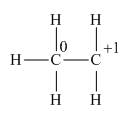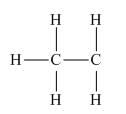
Concept explainers
Assign formal charges to each carbon atom in the given species. All lone pairs have been drawn in.
a.
 d.
d. 
(a)
Interpretation: The formal charge on each carbon atom in the given species is to be assigned.
Concept introduction: The formal charge on an atom is calculated by the formula,
Answer to Problem 1.41P
In the given species, the formal charge on carbon atom of
Explanation of Solution
The given species is
The formal charge on an atom is calculated by the formula,
Substitute these values in the above equation to calculate the formal charge.
For the carbon present in
Substitute these values in above equation to calculate the formal charge on the carbon of
Thus, in the given species, the formal charge on carbon atom of
(a) In the given species, the formal charge on carbon atom of
(b)
Interpretation: The formal charge on each carbon atom in the given species is to be assigned.
Concept introduction: The formal charge on an atom is calculated by the formula,
Answer to Problem 1.41P
In the given species, the formal charge on carbon atom is zero as shown below.
Explanation of Solution
The given species is
The formal charge on an atom is calculated by the formula,
Substitute these values in above equation to calculate the formal charge on carbon atom.
Thus, in the given species, the formal charge on carbon atom is zero.
In the given species, the formal charge on carbon atom is zero.
(c)
Interpretation: The formal charge on each carbon atom in the given species is to be assigned.
Concept introduction: The formal charge on an atom is calculated by the formula,
Answer to Problem 1.41P
In the given species, the formal charge on carbon atom is zero as shown below.

Explanation of Solution
The given species is,

Figure 1
The formal charge on an atom is calculated by the formula,
For the given carbon atom,
Substitute these values in above equation, to calculate the formal charge on carbon atom.
Thus, in the given species, the formal charge on carbon atom is zero.

Figure 2
In the given species, the formal charge on carbon atom is zero.
(d)
Interpretation: The formal charge on each carbon atom in the given species is to be assigned.
Concept introduction: The formal charge on an atom is calculated by the formula,
Answer to Problem 1.41P
In the given species, the formal charge on carbon atom of

Explanation of Solution
The given species is,

Figure 3
The formal charge on an atom is calculated by the formula,
Substitute these value in above equation to calculate the formal charge on the carbon of
For the carbon of
Substitute these value in above equation to calculate the formal charge on the carbon of
Thus, in the given species, the formal charge on carbon atom of

Figure 4
In the given species, the formal charge on carbon atom of
Want to see more full solutions like this?
Chapter 1 Solutions
Organic Chemistry
Additional Science Textbook Solutions
Applications and Investigations in Earth Science (9th Edition)
Biology: Life on Earth with Physiology (11th Edition)
Human Biology: Concepts and Current Issues (8th Edition)
Brock Biology of Microorganisms (15th Edition)
General, Organic, and Biological Chemistry - 4th edition
- Part 1. Draw monomer units of the following products and draw their reaction mechanism (with arrow pushing) Temporary cross-linked polymer Using: 4% polyvinyl alcohol+ methyl red + 4% sodium boratearrow_forwardcan you please answer both these questions and draw the neccesaryarrow_forwardcan you please give the answer for both these pictures. thankyouarrow_forward
- Part 1. Draw monomer units of the following products and draw their reaction mechanism (with arrow pushing) | Bakelite like polymer Using: Resorcinol + NaOH + Formalinarrow_forwardQuestion 19 0/2 pts 3 Details You have a mixture of sodium chloride (NaCl) and potassium chloride (KCl) dissolved in water and want to separate out the Cl- ions by precipitating them out using silver ions (Ag+). The chemical equation for the net ionic reaction of NaCl and KCl with silver nitrate, AgNO3, is shown below. Ag+(aq) + Cl(aq) → AgCl(s) The total mass of the NaCl/KCl mixture is 1.299 g. Adding 50.42 mL of 0.381 M solution precipitates out all of the Cl-. What are the masses of NaCl and KCl in the mixture? Atomic masses: g: Mass of NaCl g: Mass of KCL Ag = 107.868 g mol- 1 Cl = 35.453 g mol- 1 K = 39.098 g mol- N = 14.007 g mol−1 Na = 22.99 g mol−1 0 = 15.999 g mol 1 Question Help: ✓ Message instructor Submit Questionarrow_forwardPart 1. Draw monomer units of the following products and draw their reaction mechanism (with arrow pushing) Polyester fiber Using a) pthalic anhydride + anhydrous sodium acetate + ethylene glycol B)pthalic anhydride + anhydrous sodium acetate + glycerolarrow_forward
- Identify the missing starting materials/ reagents/ products in the following reactions. Show the stereochemistry clearly in the structures, if any. If there is a major product, draw the structures of the major product with stereochemistry clearly indicated where applicable. Show only the diastereomers (you do not have to draw the pairs of enantiomers). If you believe that multiple products are formed in approximately equal amounts (hence neither is the major product), draw the structures of the products, and show the detailed mechanism of these reactions to justify the formation of the multiple products. If you believe no product is formed, explain why briefly. (6 mark for each, except f and g, which are 10 mark each)arrow_forward3. What starting material would you use to synthesize 3-hydroxypentanoic acid using a NaBH4 reduction?arrow_forward1. Give stereochemical (Fischer projection) formulas for all (but no extras) the stereoisomers that could theoretically form during the reduction of a. the carbonyl group of 2-methyl-3--pentanone b. both carbonyl groups of 2,4-pentanedione (careful!) 2. Predict the products of the reduction of O=CCH2CH2CH2C=O with a. LiAlH4 b. NaBH4 CH3 OHarrow_forward
 Chemistry: The Molecular ScienceChemistryISBN:9781285199047Author:John W. Moore, Conrad L. StanitskiPublisher:Cengage Learning
Chemistry: The Molecular ScienceChemistryISBN:9781285199047Author:John W. Moore, Conrad L. StanitskiPublisher:Cengage Learning Chemistry: Principles and PracticeChemistryISBN:9780534420123Author:Daniel L. Reger, Scott R. Goode, David W. Ball, Edward MercerPublisher:Cengage Learning
Chemistry: Principles and PracticeChemistryISBN:9780534420123Author:Daniel L. Reger, Scott R. Goode, David W. Ball, Edward MercerPublisher:Cengage Learning

